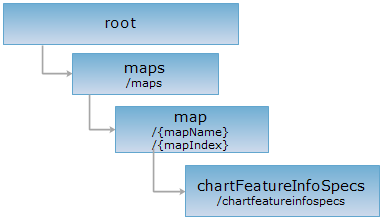URI
<map_uri>/chartfeatureinfospecs[.<format>]
Supported methods
Parent resource
ERROR: Variable (map_link) is undefined.
Introduction
The chartFeatureInfoSpecs resource is all supported nautical chart product feature info list. It is used to describe the basic information of the features abiding by different product specifications, including feature name, feature type, and feature attribute information.
Supported Methods:
- GET: Gets all supported nautical chart product feature info list.
- HEAD: Gets the meatadata information of the chartFeatureInfoSpecs resoruce. Checks whether the chartFeatureInfoSpecs resource exists, whether the parameters are valid, or whether there are access permissions.
Supported output formats: rjson, json, html and xml.
Resource hierarchy

HTTP request methods
Implement the HTTP request on the following URI, where supermapiserver is the server name and WorldMap is the map name {mapName}, with rjson being the output format.
http://supermapiserver:8090/iserver/services/map-world/rest/maps/WorldMap/chartfeatureinfospecs.rjson
GET request
Gets all supported nautical chart product feature info list.
Response structure
A nautical chart feature class list will be returned after Implementing the GET request on the chartFeatureInfoSpecs resource. Below is the representation structure for one feature.
| Field | Type | Description |
| acronym | String | The feature acronym. |
| attributeFields | List<ChartAttributeSpec> | The attribute fields of the feature. |
| code | int | The code of the feature. |
| localName | String | The localized name. |
| name | String | The name of the feature. |
| primitive | String | The object type which could be applied by the feature. |
Example usage
The rjson format representation of implementing the GET request on the chartFeatureInfoSpecs resource http://supermapiserver:8090/iserver/services/map-world/rest/maps/WorldMap/chartFeatureInfoSpecs.rjson will be as follows:
Head request
Asks for the response identical to the one that would correspond to a GET request, but without the response body. This is useful for retrieving meta-information written in response headers, without having to transport the entire content. The meta-information includes the media-type, content-encoding, transfer-encoding, content-length, etc.
HEAD request can be used to check if the chartFeatureInfoSpecs resource exists, or if the chartFeatureInfoSpecs resource can be accessed by clients. It can also determine if the chartFeatureInfoSpecs resource supports an output format <format> if performed on a URI with .<format> included.
See
- ERROR: Variable (map_link) is undefined.
- Constructing REST Requests
- Status Codes
- Output Formats
- Resource Hierarchy